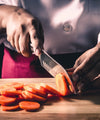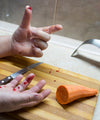Recent Post
Archive
- November 2021
-
- How to choose the right kitchen knife for the right chopping job.
- How to help reduce 60,000 knife accidents a year in the kitchen!
- HELPING THE EARTH – Why Bamboo chopping boards are the best?
- What is the BEST kitchen chopping board type?
- The Best Kitchen Knives & Why?
- Save Money – On GREAT kitchen knives
- October 2021
Tags
Custom Menu

How to choose the right kitchen knife for the right chopping job.
Kitchen knives used incorrectly.
There is a lot of ‘confusion and misunderstanding’ of ‘what kitchen knife should be used for different chopping and slicing in the Kitchen’
Let’s face it, you wouldn’t or shouldn’t use a butter knife to open a paint tin and expect great results!
Or, you wouldn’t use a pozidriv (yes, the correct spelling is pozidriv!) screwdriver on a flat head screw and expect great results!
Remember the old adage ‘A bad workman always blames his tools?’
Well, 60,000 knife accidents a year in the UK kitchens is as a result of either the ‘wrong’ or ‘blunt’ knives being used – FACT!
A complete understanding of kitchen knife types.
Whether you are slicing and dicing, or carving and paring, every capable or proficient cook will tell you that the correct knife needs to be used for different processes.
This guide will help you make the right choice of knife for the different processes.
Basic principles of each knife’s purpose.
Is it important to use the correct knife for the correct purpose? It may sound obvious but, sometimes we expect too much from the wrong knife type.
To avoid being one of the 60,000 knife accidents a year in the UK kitchens, it is important to remember the basic principles of the right knife for the right job.
A carving knife won’t work well to cleave and, if it does, you’re probably using too much force and damaging the blade, OR risking injury.
A paring knife won’t work well chopping heavy vegetables, that’s NOT it’s job, it’s for more delicate work like de-seeding peppers and coring tomatoes, a small and nimble paring knife is better.
The chef / santoku knife is a great multitasker, used for virtually everything.
Remember - Larger knives (Chef / Santoku) are for heavy cutting and chopping, smaller knives (Paring) are for more delicate work.
How many different types are needed in the Kitchen?
Well, Gordon Ramsay and the Food Network have answered that many times!
Gordon Ramsay…
"Basically, you need three knives," he said in the video. These include the Chef's Knife (for chopping), a serrated knife (for carving, slicing, and working with breads or anything that has a hard exterior and a softer interior), and a Paring knife (for peeling, mincing, dicing, etc.).
Food Network…
“There are only three knives that are crucial in a kitchen: a chef's knife, a paring knife and a serrated knife. Any other knives are a luxury and unnecessary”
Here we look at these three ‘GO TO’ knives and what they should be used for.
Chef or Santoku Knives.
The chef or Santoku knife is one of (if not) the most popular and versatile knives to have in any kitchen.
It is particularly well designed for general cutting and chopping.
Preferred by the majority of the chefs around the world.
The correct usage of this knife is for the following processes.
It is Ideal for:
• Slicing, chopping, dicing vegetables
• Slicing herbs
• Chopping nuts.
• Cutting meat
• Disjointing some cuts
Not ideal for:
• Cleaving meat bones
• Carving dense meat
• Disjointing some cuts
• Slicing bread
• Smaller precision tasks, such as peeling and mincing. (This process is for the PARING KNIFE)
Paring Knives.
The most ‘misused knife’ in the kitchen!
This knife is small, it is NOT meant to ‘chop’ hard or heavy vegetables, the paring knife should be used for intricate paring, cutting, peeling, trimming, mincing and dicing. The blades are simple, sharp and precise.
It’s called a ‘PARING’ knife for a reason!
It looks like a miniature chef's knife, but its use is very different. The paring knife is ideal for peeling fruits and vegetables; slicing a single garlic clove or shallot; controlled, detailed cutting, such as cutting shapes or vents into dough; and scoring designs and patterns on surfaces of food. It is best used for any job that requires precise and delicate work, like removing the ribs from a jalapeño or coring an apple.
Unlike the chef's knife, which is always used on a cutting board, you can cut with the paring knife while holding it aloft for peeling etc., think of it an extension of your hand. The small handle gives the cook maximum control over the tip and the edge of the blade.
Ideal for:
• Peeling and cutting small fruit and vegetables
• Deseeding fruits
• Deveining prawns
• Cutting vegetables & herbs such as garlic
Not ideal for:
• Cutting or chopping larger and tougher vegetables
• Pumpkin or other squash
• Preparing or slicing meat, including carving & deboning
• Slicing bread
Bread / Serrated Knives.
Are more versatile than given credit for.
The long blade and sharp serrated edge of a bread knife makes it the perfect tool for sawing through all sorts of food.
The serrated and grooved edge allows the chef to cut through softer textures without crushing them out of shape.
Ideal for:
• Loaves of all types
• Crusty bread
• Baguettes
• Bread rolls
• Bagels
• Slicing cakes with soft and fluffy textures, they cut through them without removing the air from the sponge or damaging the shape.
• If you don’t have a cake leveller in your kitchen, a bread knife can even be used successfully to even out your sponge cakes after baking.
• Cooked meats
• Poultry
Not ideal for:
• Detailed slicing and dicing
• Intricate cutting
We hope the guide has been helpful.
← Older Post Newer Post →





